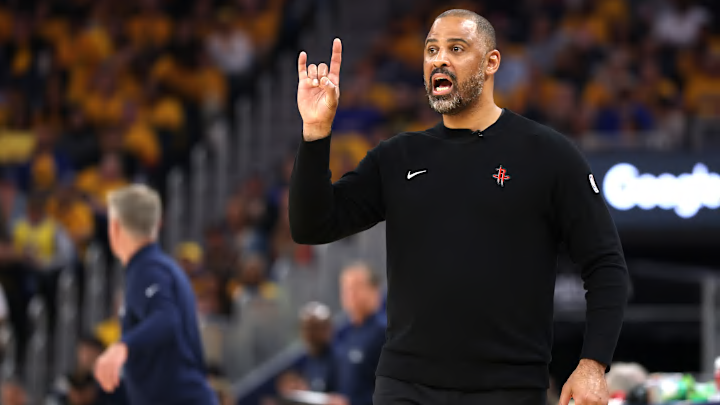The Houston Rockets posted their best season since the James Harden era, finishing 52-30 and securing second place in the Western Conference. Their identity revolved around rebounding, physicality and overall defense. Ime Udoka’s double-big lineups and focused defense ranked them among the league’s best on that end of the floor.
However, Houston’s weaknesses were more than noticeable when it came to shooting inefficiency, especially from behind the arc. As the Rockets hope for deeper playoff runs in the future, important offseason acquisitions, specifically, a strong replacement for Adams and a proven perimeter shooter, will be essential. Addressing these needs will push the Rockets over the hump, turning them into true contenders.
Replacing Steven Adams
Steven Adams helped transform Houston’s interior presence. With his impending free agency, it’s likely a wrap for Adams in H-Town. Although Alperen Sengun has grown by leaps and bounds over the past two years, having another dependable big who can anchor the glass and protect the rim should be at the top of the offseason wish list.
Steven Adams on Instagram:
— Bradeaux (@BradeauxNBA) May 7, 2025
“Houston, thank you.
The energy, passion, and unwavering support you brought to the arena this year were nothing short of incredible.
I hope we represented this city with the pride and resilience that define what it means to be a Houstonian.
Going… pic.twitter.com/4co9I7oe6P
“Houston, thank you. The energy, passion, and unwavering support you brought to the arena this year were nothing short of incredible. I hope we represented this city with the pride and resilience that define what it means to be a Houstonian. Going to battle with the brothers was an honor. We fought with grit, heart, and determination displaying the kind of resilience that goes beyond the court. Proud of the boys and everything we learned together.” – Steven Adams following Rockets first-round elimination
Houston’s defense and rebounding by the numbers
This season, the Rockets averaged 48.5 rebounds per game. They lead the playoffs in rebounding (46.9 RPG) and have been out for two rounds. Houston finished sixth during the regular season in opponents points per game, allowing just 109.8 points. Their defensive rating ranked fifth in the NBA (110.3), thanks in part to controlling the glass and limiting transition baskets.
Adams’ physicality, box-outs and ability to clear space for Sengun and others made the Rockets a nightmare on the boards. Without him, the team’s rebounding percentage and second-chance points dipped noticeably. In a stacked Western Conference, maintaining this edge is a necessity.
Potential Adams replacements: Brook Lopez, Andre Drummond, Clint Capela
• Brook Lopez: Averaged 5 rebounds and 1.9 blocks per game this season with Milwaukee. Lopez stretches the floor (37.3% from three) and anchors the paint defensively. His contract could be sizable, but his ability to space and defend makes him a strong fit, especially for a team needing all his skills.
• Andre Drummond: Drummond’s rim protection isn’t at Lopez’s level, but his rebounding is elite. He’s likely more affordable and can be a plug-and-play option for Houston’s second unit.
• Clint Capela: Rockets fans know Capela well. He posted 8.5 rebounds and 1 block per game for Atlanta this season. Capela thrives as a lob threat and rim runner, bringing familiarity and consistency. His contract is mid-tier.
Key takeaway: Any of these bigs would help the Rockets maintain their rebounding and defensive identity. Lopez adds a unique ability to stretch defenses; Drummond offers bargain rebounding and Capela provides a versatile fit.
A reliable perimeter shooter
Houston’s defensive surge could not hide their persistent shooting struggles. They finished near the lower third of the NBA in three-point and field-goal percentage, making floor-spacing the team’s most obvious offensive need. Acquiring a knockdown shooter is another critical offseason acquisition.
The Rockets shot just 35.3 percent from three (21st in the league) and 45.5 percent from the field (21st). In the playoffs, opponents packed the paint, daring Houston’s wings to beat them from outside, a strategy that worked, as Houston’s offensive rating dropped to 111.5 in the postseason from 114.9. Simply put, without a reliable shooter to draw extra defenders, Houston’s offense will continue to sputter against top defenses.
Adding a Shooter: Cam Johnson, Malik Beasley, Gary Trent Jr.
• Cam Johnson: Hit 39 percent from three for Brooklyn, averaging 18.8 (career high) ppg. Johnson is a tall wing with the versatility to defend multiple positions. His contract is mid-range, but his shooting and size would be a game-changer for the Rockets’ spacing.
• Malik Beasley: Was successful at 41.6 percent from deep on high volume for Detroit, attempting over nine threes per game. Beasley thrives as a movement shooter and can play off Houston’s playmakers, but his defense is average and best suited as a sniper off the bench.
• Gary Trent Jr.: Shot 41.6 percent from three and averaged 11.1 ppg for Toronto. Trent brings two-way skills and the ability to create his own shot. He’s a more complete option if Houston wants a player who can stay on the floor in crunch time.
Key takeaway: Any of these shooters would add a sorely needed scoring punch. Johnson offers size and versatility, Beasley pure shooting and Trent a strong two-way presence.
This Rockets team rebounded from the lottery to a 52-game winner on the back of elite rebounding and defense. However, the loss of Steven Adams and the team’s lack of reliable shooting exposed them when it mattered most. The smartest offseason acquisitions for Houston are a proven big to replace Adams and a high-volume perimeter shooter.
Plugging these holes could unlock the next level for Udoka’s squad, balancing their defensive strengths with enough firepower to seriously threaten the NBA’s elite. With a few strategic moves, the Rockets could be ready to take that next step toward a deep playoff if not a championship in the near future.
